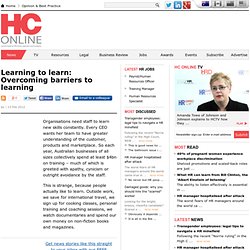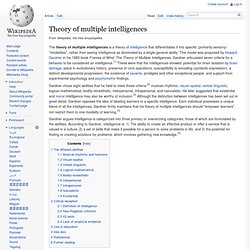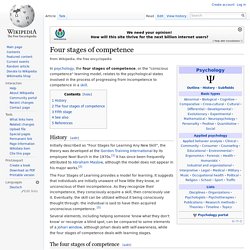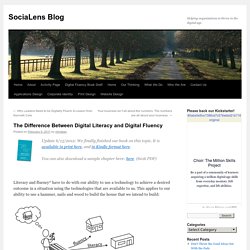

On Creativity & Education - Animation of Sir Ken Robinson's TEDtalk. Learning to learn: Overcoming barriers to learning - Human Capital. Organisations need staff to learn new skills constantly.

Every CEO wants her team to have greater understanding of the customer, products and marketplace. So each year, Australian businesses of all sizes collectively spend at least $4bn on training – much of which is greeted with apathy, cynicism or outright avoidance by the staff. This is strange, because people actually like to learn. Outside work, we save for international travel, we sign up for cooking classes, personal training and coaching sessions, we watch documentaries and spend our own money on non-fiction books and magazines. Get news stories like this straight to your inbox with our FREE newsletter The mystery is why do people so often disengage from learning and resist the new in the work environment? The most widely agreed reason is that people don’t have time, and it’s hard to argue with that one. The second reason why teams can seem uninterested in learning is less openly recognised. And the third reason is a bit sad.
Theory of multiple intelligences. The theory of multiple intelligences is a theory of intelligence that differentiates it into specific (primarily sensory) "modalities", rather than seeing intelligence as dominated by a single general ability.

This model was proposed by Howard Gardner in his 1983 book Frames of Mind: The Theory of Multiple Intelligences. Gardner articulated seven criteria for a behavior to be considered an intelligence.[1] These were that the intelligences showed: potential for brain isolation by brain damage, place in evolutionary history, presence of core operations, susceptibility to encoding (symbolic expression), a distinct developmental progression, the existence of savants, prodigies and other exceptional people, and support from experimental psychology and psychometric findings.
Gardner argues intelligence is categorized into three primary or overarching categories, those of which are formulated by the abilities. The different abilities[edit] 5 Stages of Workplace Learning. Learning styles. Learning style is an individual's natural or habitual pattern of acquiring and processing information in learning situations.

A core concept is that individuals differ in how they learn.[1] The idea of individualized learning styles originated in the 1970s, and has greatly influenced education.[2] Proponents of the use of learning styles in education recommend that teachers assess the learning styles of their students and adapt their classroom methods to best fit each student's learning style. Although there is ample evidence for differences in individual thinking and ways of processing various types of information, few studies have reliably tested the validity of using learning styles in education.[2] Critics say there is no evidence that identifying an individual student's learning style produces better outcomes. David Kolb's model[edit] David A.
David Kolb’s Experiential Learning Model (ELM) [5] 1. 2. 3. 4. Learning Modalities[edit] 1. 2. 3. Dreyfus model of skill acquisition. In the fields of education and operations research, the Dreyfus model of skill acquisition is a model of how students acquire skills through formal instruction and practicing.

Brothers Stuart and Hubert Dreyfus proposed the model in 1980 in an influential, 18-page report on their research at the University of California, Berkeley, Operations Research Center for the United States Air Force Office of Scientific Research.[1] The original model proposes that a student passes through five distinct stages: novice, competence, proficiency, expertise, and mastery. The original five-stage model[edit] Michael Eraut summarized the five stages of increasing skill as follows:[2] Instead the original Dreyfus model is based on four binary qualities: Recollection (non-situational or situational)Recognition (decomposed or holistic)Decision (analytical or intuitive)Awareness (monitoring or absorbed)
Four stages of competence. In psychology, the four stages of competence, or the "conscious competence" learning model, relates to the psychological states involved in the process of progressing from incompetence to competence in a skill.

History[edit] The Four Stages of Learning provides a model for learning. It suggests that individuals are initially unaware of how little they know, or unconscious of their incompetence. As they recognize their incompetence, they consciously acquire a skill, then consciously use it. Eventually, the skill can be utilized without it being consciously thought through: the individual is said to have then acquired unconscious competence. [3] Several elements, including helping someone 'know what they don't know' or recognize a blind spot, can be compared to some elements of a Johari window, although Johari deals with self-awareness, while the four stages of competence deals with learning stages.
Digital Literacy + Digital Fluency. Update 6/13/2012: We finally finished our book on this topic.

It is available in print here, and in Kindle format here. You can also download a sample chapter here: here (601k PDF) Literacy and fluency* have to do with our ability to use a technology to achieve a desired outcome in a situation using the technologies that are available to us. This applies to our ability to use a hammer, nails and wood to build the house that we intend to build: ..and it applies to our ability to use digital technologies to have the intended positive effect on people and situations: A Momentary Flow. Learning Acceptance Model.